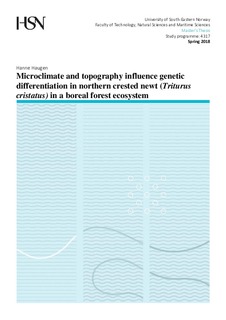| dc.description.abstract | Among all vertebrates, the amphibians is the group that currently has the highest proportion of threatened species, and monitored populations have suffered large declines since 1970. The most widespread threat is loss of habitat. Habitat loss makes the reduced populations more dependent on immigration for survival. Moreover, habitat loss often leads to habitat fragmentation, which tends to increase population isolation, and thereby expose them to several genetic threats. Immigration can counteract these threats. Investigation of spatial patterns and levels of population genetic differentiation are fundamental for knowledge-based conservation measures. The northern crested newt (Triturus cristatus) is a pond breeding amphibian which shows a decreasing population trend in Europe, and is listed as near threatened in Norway. I studied the northern crested newt in a boreal forest ecosystem subject to fragmentation and habitat loss by clear-cutting and road-building. It was documented that the intervening landscape between breeding ponds, affect the genetic differentiation, in addition to the isolation-by-distance effect. Data and analysis indicated that both microclimate and topography may play a role. South/south-west facing slopes, slopes 30° and steeper and gravel roads in addition to geographical distance, increased genetic differentiation, i.e. reduced landscape permeability for northern crested newts. The opposite effect was observed for streams, presumably more favorable for newt dispersal. Furthermore, populations within or directly adjacent to old forest had a higher allelic diversity than populations outside these areas. Such areas may therefore be important source habitats in the conservation of northern crested newt populations. | nb_NO |
